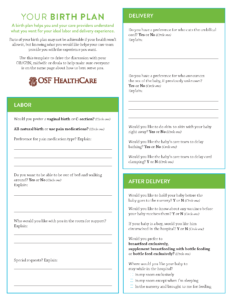If you’ve never given birth before, you may be surprised at how many decisions you have to make. To avoid feeling overwhelmed during labor, it’s wise to make a birth plan before your due date.
A birth plan is a document that lists your preferences for your labor and delivery experience. It’s most effective when used to drive discussions with your pregnancy care provider, whether that’s an OB/GYN, midwife or doula.
Most labor and delivery nurses will tell you that a well thought out birth plan is very helpful for them, as well. They want to make sure your experience is a positive one.
However, every delivery is different, and complications can occur. Your care team may have to disregard part of your birth plan for medical reasons.
“If a nurse can support your birth plan, she certainly will. But she has to make sure your care is safe and your infant’s care is safe,” said Mary Grimm, birthing center manager for OSF HealthCare. “When you come with a birth plan, we will work with you to try to honor everything that’s medically safe for you and your infant.”
What a birth plan includes
Birth plans are usually divided into three sections, each section addressing a different phase of your labor and delivery.
During labor
Labor can last several hours, so what would you like from your care team as your body prepares for delivery?
Among other questions, ask yourself:
- Do you want pain medication?
- Do you want an epidural or something else?
- Do you want to be up and walking around?
- Would you like to have an IV?
- Whom would you like to be allowed in the room with you – maybe the baby’s father or another family member?
During delivery
Delivery can be a bit overwhelming, with so many things happening quickly. With both the mother and baby receiving care, it can seem like a lot of people are busy and active around the room.
Before delivery, ask yourself:
- Would you like someone other than your provider to cut the umbilical cord?
- Do you want your support person to announce the sex of the baby?
- Do you want to do skin-to-skin right away? For how long?
- Do you want to delay bathing?
- Do you want delayed cord clamping?
After delivery
After you deliver your baby, what kind of care, guidance or assistance do you want for yourself and your baby? If you’re at a hospital or birthing center, you will likely be there for a night or two, so think about how you’d like your stay to go as you recover and bond with your baby.
The American Academy of Pediatrics recommends certain vaccines, vitamin K, ointment drops for the eyes, and more for newborns. Do you want these standard procedures for your baby?
It’s wise to also consider:
- How would you like to feed your baby?
- Would you like a breastfeeding consultation in your room?
- If your baby’s a boy, do you want him circumcised?
How to make a birth plan
You likely wonder where you should start in making your birth plan.
“As soon as you choose your provider, you can tell them you want to look up some resources about birth plans,” Mary said. “They may be able to give you some recommendations.”
Your provider can help you pick a birth plan template that fits the type of birth you plan to have. Some templates are better suited to a hospital delivery while some are made for home deliveries. Some templates are made for vaginal deliveries while some are more suited for a C-section delivery.
There are plenty of birth plan examples online to give you an idea of what a completed birth plan looks like, too. It can be helpful to see how others have created birth plans.
The earlier you begin discussing your birth plan with your provider, the better. This will allow you time to research the topics before making decisions. You can research these topics online and speak with your care provider, as well as friends and family who can speak from experience.
Your provider can also set realistic expectations and let you know what is and what is not possible for your unique circumstances.
Another way to find out what your options are is to tour the birthing facility where you’re going to deliver and ask questions about the accommodations and rules. Some places allow you to pick music to play in the delivery room, for example, so you can prepare your favorite music to be played.
Last Updated: September 21, 2023

